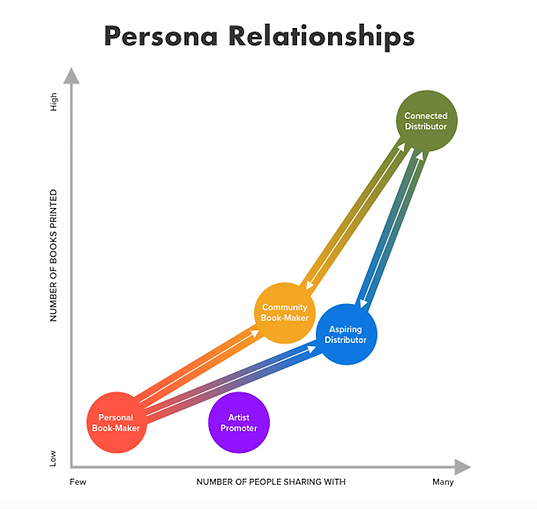Featured Case Study
Case Study
Creating personas for a
book-making platform

Overview
Blurb, a bookmaking platform and creative community, has users with markedly different goals and motivations. The organization’s challenge was that there were different definitions of whom we were serving and what they needed.
Additionally, we had significant UX debt around “trying to be all things to all people” which inadvertently led to compromising how well we were serving our users overall.
We desired a better understanding of different user-types' goals and key tasks and a framework for thinking about them. Creating user personas would help us better align about who our users were and be smarter about product and design decisions.
Challenge
We needed to better define and understand our different types of users' goals, motivation and behaviors. We also wanted to socialize our findings across the organization.
Process
THE TEAM
This project was initiated by the UX Manager/Designer and myself and I managed it end-to-end. Before kick-off, I promoted the research via our product and marketing Slack channels to invite our cross-functional partners to observe interviews. There was wide interest in participating in this way, including from company leadership.
UX
RESEARCH

UX
RESEARCH
(me)
UX
DESIGNER
HEAD OF PRODUCT
PRODUCT
MANAGER
web
PRODUCT
MANAGER
tools
PRODUCT
MANAGER
platform
MARKETING
retention
MARKETING
acquisitions
MARKETING
brand
CEO
COO
THE PLAN
Based on stakeholder interviews and our own assumptions, we identified our hypotheses about our users that we would seek to validate or disprove. Then I crafted an interview guide, with input from my UX partner.

Interviews would be conducted remotely via video conference and we would also share screens so we could see users’ books and how they used their dashboard. Through the interview, we would understand their needs, motivations and key tasks related to their book-making (and selling as well, if they were also distributing their book). Observers would be able to submit questions to me, the moderator, toward the end of each interview session.
RECRUITING
I employed a few methods to recruit participants. First, I posted a pop-up invitation that would appear throughout our website using Hotjar. Users could follow a link from the pop-up to fill out a screener that I would subsequently select from.

I also used a research panel I had been building and directly emailed the screener to users that were opted-in to receive research invitations. The screener was not very restrictive given we were taking an exploratory approach; however, we did want to make sure we had representation from a broad range of users, as well as sellers and non-sellers.
IN-DEPTH INTERVIEWS & CONTEXTUAL INQUIRY
I remotely interviewed over 30 users. Participants displayed their screen to show their book-making work and demonstrate how they use their dashboard and tools. Stakeholders from across the organization sat in on interviews in an observation room. In addition to to having the option to submit questions, observers were invited to a short debrief following each session.

*User granted permission for use of image in this case study
ANALYSIS
Once interviews were completed, I looked for patterns using affinity mapping and cluster analysis, along with my UX Manager/Designer partner. Additionally, I drew from previous interviews from past research for additional data points. We formed and mentally tested ideas as they emerged.


We also looked for relationships across types as they were forming, recognizing that there was a continuum between some. While most users would cluster around one "type", any given real user may fall somewhere along the path between these stereotypes.

Outcome
FINDINGS & SHARING OUT
-
I landed on 5 distinct personas and recommended a particular one be designated as a primary focus for product and design.
-
The primary persona represented the greatest business opportunity and was the one that would not have their needs met if we designed primarily for any of the other personas. Conversely, if we designed for this primary persona, other users would be fine.
-
Along with the UX Manager / Designer, I shared the personas with C-staff and cross-functional teams. We also put up posters in common areas, posted on our wiki page and shared in Slack channels to help socialize the personas across the organization.






ADDITIONAL OUTCOMES / FURTHER WORK
-
Usability and UX issues: Over the course of our work, several usability and UX issues were surfaced. With the product manager, we created a list for further investigation, made tickets or put them in the backlog. We prioritized work related to supporting the primary persona, now that we were aligned as a result of this research.
-
Marketing Segments vs. Personas: Over the course of the project, there was great interest from marketing and leadership to leverage the personas for targeting customers, brand positioning and messaging. We needed to have a discussion internally about what personas were— and were not. The personas were primarily to guide user-centered design. Marketing segments, while they may overlap, do not necessarily map 1 : 1.
-
Previous quant research to build on: A previous survey I ran gave us some information about a creative-pro marketing segment which comprised a big portion of our users. We theorized that this marketing segment transcended the persona constructs we had devised. We recommended further work I could do to define our marketing segments and explore how they tied to these personas.